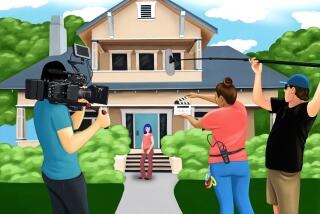NUTS & BOLTS : A How to for Homeowners : Placement of Speakers Key Factor in Sound
- Share via
Where did you go wrong? Let’s review:
You’ve been reading The Playboy Advisor faithfully for a quarter century now, doggedly avoiding the sex letters and going straight to the stereo questions. You know what ohms are and you can say woofer and tweeter without cracking up.
So you went out and bought yourself a Megablast Ground Zero X-8000 Audio Assault System, the one guaranteed to make the neighbors’ garage implode, and you spent the Memorial Day weekend wiring it up.
And it works.
But it’s not . . . right. Sure, it’ll make your ears bleed, but your favorite recording of the Mahler Eighth Symphony still sounds like it’s being played in a cave.
Take a look around with an audio technician’s eye, then, says Christopher Hansen, and you might discover that you’ve set up your baby in an environment with all the acoustical forgiveness of a squash court. Because, says Hansen, who runs Christopher Hansen Ltd, an audio consulting business in Los Angeles, a bad room can nullify a good stereo as surely as scissors cut paper.
What’s a bad room? Any place that looks like it could produce reverberation.
“You want to hear the sound from the speaker,” Hansen says, “and some of the reflected sound, but when the reflected sound overpowers the direct sound from the speakers, things get confused. It’s like taking pictures from 50 different angles and placing them over each other. It won’t make sense.”
Reflected sound, then, is the villain here, and one you might remember from high school physics (remember that lecture on properties of waves where you used the Slinky?). For a good illustration of how it can bollix up your sound system, we can go back to the squash court.
Sound waves act in much the same way the squash ball does when you whack it against the concrete front wall of the court. It bounces aggressively back at you, quickly and hard. And if you hit it hard enough, it just keeps on bouncing off the walls until it runs out of steam.
Now, imagine the front wall lined with down pillows. What kind of bounce will you get off them?
It follows, then, that if you’ve got your CD of the 1812 Overture cranked up to the filling-melting level in a room with a parquet floor, concrete walls and ceiling, big uncovered windows and a sliding glass door, you’re going to feel like you’re caught in the cross-fire.
But, Hansen says, if you lay down a carpet, put some acoustical tile on the ceiling, give the walls some relief (with framed pictures, for instance, or plants), hang up some curtains and make sure that your furniture isn’t made out of granite, then you can get your cannon shots straight from the source: the speakers. That’s what you want.
If you want a truly dramatic illustration of this, find a big stone church and drop in when the organ’s playing or the choir’s singing. Then, quick, jump in the car and drive to the nearest stereo store, go into the room where they keep the demo speakers and just start talking. Your words will never have sounded so focused.
Of course, lining your entire living room in acoustical tile may not be what you had in mind. Still, says Hansen, you can improve matters simply by shoving a few pieces of furniture around--mostly the speakers.
“If your room is set the way you want it,” he says, “and you can’t physically do anything with it, one of your options is placing the speakers on different walls or different placements in the room and listening to them. There’s a very large difference in sound in terms of speaker placement.”
Even before you do this, though, it’s essential to know whether your speakers are designed for the wall or the floor. If they’re floor-standing, Hansen says, put them on stands, off the floor and generally away from the walls. This is especially important if you have downstairs neighbors.
But don’t place the speakers too far apart.
“Most people are under the misconception that you have to have your stereo speakers as far apart as possible,” says RoxAnn Johnson, an interior designer whose new company, Audio-Visual Environments in Orange, specializes in custom home electronics. “That’s not really the best idea in the world. In general, if you put your speakers six to eight feet apart, it’s really better. Most people have rooms where they can’t be far away enough to warrant, say, a 12-foot separation.”
Also, Johnson says, more and more people are patching their television through their stereo system, and if the speakers are too far apart, “the sound doesn’t seem to come from what you’re looking at. In that case, it’s better to have the sound anchored to the video.”
It’s also a good idea, Johnson says, to try to arrange the furniture in such a way that people who are seated in the room--on a sectional couch, for instance--can face the source of the sound squarely, rather than at an acute angle. Your ears are hugely sensitive, and cocking your head one way or another affects the way you perceive the sound.
Ultimately, says Hansen, bigger is not necessarily better. If your Megablast system has speakers the size of a stretch limo and you live in, say, a hollow tree, you might want to develop a better sense of proportion. In your case, small is beautiful. Leave the satellite dish-sized woofers to people with living rooms the size of the Astrodome.
Your neighbors will love you for it.
More to Read
The biggest entertainment stories
Get our big stories about Hollywood, film, television, music, arts, culture and more right in your inbox as soon as they publish.
You may occasionally receive promotional content from the Los Angeles Times.










